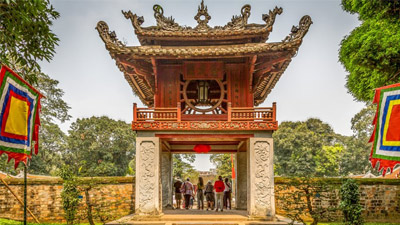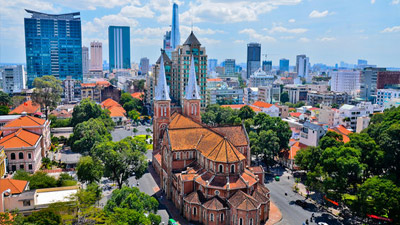Vietnam's Water Puppetry
 Vietnam's water puppetry (so-called "Mua Roi Nuoc" in Vietnamese) is an old form of puppetry that originated from wet rice civilization in the Red River Delta in Northern Vietnam during Ly Dynasty (1010 - 1225). Over centuries of forming and developing, water puppetry has become typical form of art performance in the North.
Vietnam's water puppetry (so-called "Mua Roi Nuoc" in Vietnamese) is an old form of puppetry that originated from wet rice civilization in the Red River Delta in Northern Vietnam during Ly Dynasty (1010 - 1225). Over centuries of forming and developing, water puppetry has become typical form of art performance in the North.
Puppets used in water puppetry are made from a special kind of wood named “sung”. This kind of wood is featured with light weight and flexibility that makes it easy to control. Logs are sophisticatedly carved to have different blocks. Then, those blocks will be connected in a system and painted by many colors. Finally, living puppets are completed and ready for the performance. On the stage of water puppetry, there is a famous and outstanding character named “Teu”. The puppet called “Teu” usually has a plump body and lovely face. “Teu” is a little boy that plays the role of narrator and joker, as well as represents the masses. “Teu” has the love of many generations of Vietnamese people and has become a symbol of water puppetry.
The unique feature of Vietnam’s water puppetry is its stage. Differ from other kinds of puppetry in the world that perform on ground stage, Vietnam’s water puppetry is performed on water stage. Water stages are usually built on small pool, and resemble a temple with a split-bamboo screen. Puppeteers stand all behind the screen and control puppets performing a play or a dance through a long string mechanism under water surface. To do this work, puppeteers have to stand in cold water for hours.
To assist puppeteers in puppetry performance, there is an orchestra which plays traditional instruments such as vocals, drums, wooden bells, cymbals, horns, erhu (Chinese two-stringed fiddle), and bamboo flutes. Exciting background music combined with amazing stage of living puppets and colorful flags bring audience a bustling ambiance of traditional festival in the country.
Vietnam’s water puppetry is a notable form of art performance in Vietnam and has been widely introduced to international community. It now is nominated to be a UNESCO’s Intangible Cultural Heritage.

Ca Tru Singing
"Ca tru" singing is an old form of singing in the North of Vietnam that originated and flourished in around 15th century. In different regions, "ca tru" singing has different names such as "A dao"...

Vietnam Cai Luong
Cai Luong is a type of performance coming from the South Vietnam and formed from the traditional music of the Mekong River Delta.

Chau Van Singing
"Chau Van" (or "van" singing) is an ancient form of art performance that is featured with religious color. It originated in the Red River Delta of Northern Vietnam in around 16th century and widely...

Cheo Singing
"Cheo" is a traditional form as well as a typical representative of Vietnamese opera beside "Tuong" and "Cai Luong". "Cheo" is a form of art performance that is very popular in the North of Vietnam,...

Then Singing
"Then" singing is a traditional kind of oratorio art in Vietnam. That form of art performance originated form religious activities of Tai, Tay and Nung ethnic groups in Northern Vietnam. The name...

Hue's Royal Court Music
Hue's royal court music is called "Nha Nhac Cung Dinh" (Royal court's refined music) in Vietnamese. It's an old form of art performance that used to official music of royal court for centuries. For a...
Vietnam Travel Guide
- Vietnam Overview
- Vietnam Geography
- Vietnam History
- Vietnam Ecology And Environment
- Vietnam Government And Politics
- Vietnam Economy
- Vietnam Demographics
- Vietnam Customs
- Vietnam Art Performance
- Vietnam Religions
- Vietnam Festivals
- Vietnam Gastronomy
- Get To Vietnam
- Vietnam Travel Tips
- Vietnam Travel Articles & News

 BEST TOURS
BEST TOURS



